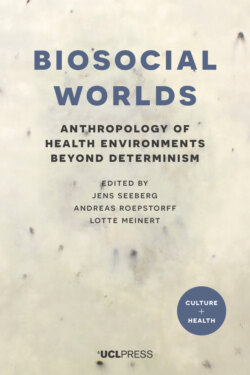Читать книгу Biosocial Worlds - Группа авторов - Страница 14
На сайте Литреса книга снята с продажи.
Beyond determinism
ОглавлениеBiosocial worlds, therefore, are created in the engagement with the human condition more broadly, as described in this volume, and they are co-created by these descriptions, either as propositions or as critiques. Building on Lock (this volume), we have suggested that the tendency in biology to downscale the environment to something that is experimentally practical is a threat to the understanding of biosocial dynamics. Here, biology may learn from anthropology.
However, this raises the problem of scale and how to work across very different scales of experience. In their common forms of knowledge production, biology has access to knowledge at scales that are usually inaccessible to anthropology, whereas anthropology has access to theoretical understanding of social complexities that are inaccessible to biology. This anthropological contribution points to the need for developing an analytics of biosocial complexity that may very well come at the cost of some of the taxonomical neatness that has been a founding principle of biology, and therefore of biomedicine.
How is it possible to pursue this agenda in shared spaces of exploration and interdisciplinary dialogue between anthropology, biology and medicine? Many cases presented in this volume indicate – and critically challenge – such spaces, whether they be laboratories or clinical spaces (Svendsen; Niewöhner; Livingston); biosocial spaces where the microscopic may be integrated in anthropological analysis (Young; Seeberg); or the broader exploration of the effects of tensions between biologically grounded categories and biosocial complexities (Lock; Napier; Meinert and Whyte; Petryna).
Clearly, the degree of proximity matters. The closer the collaboration, the greater the need for scientists to find mutually agreeable entry points for interdisciplinary dialogue and exploration. We suggest that the focus on scale may be a useful entry point, not for a backward-looking re-enactment of disciplinary boundaries within neatly carved ‘scalar’ principles, but as a point of fruitful exploration of such boundaries with the intention of challenging and reshaping them, accepting that scale and scalability are also political and moral spaces, and that the ‘non-scalable’ (Tsing 2015) should not be lost from analysis.
Doing so may open spaces for the larger issues of complex synergies between biosocial entities otherwise too often conceptualised as distinct, as well as the definition of environment, which in anthropology is closely related to the fluid engagement with the concept of context. Our book requires a move beyond the Darwinist luggage of adaptive evolution that has provided not only the core of biological determinism up to its human genomic climax, but has also spilled over into many other domains, as shown in this volume.
